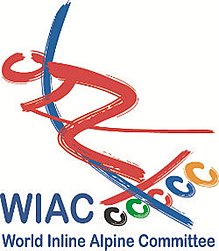Inline Alpine World Cup
The Inline Alpine World Cup is an inline Alpine competition series that was organized from 2010 to 2014 by the World Inline Alpine Committee (WIAC) and the respective national association. The Comité International de Roller Alpine (CIRA) has replaced the WIAC since 2015 . Before the introduction of the World Cup, there was the Inline Alpine European Cup from 2004 to 2009 .
history
In 2010 the inline organization Inline-Europa-Cup-Committee (IAEC) decided not to continue the European Cup. Instead, the inline organization World Inline Alpine Committee (WIAC) was founded because Japan wanted to be the first non-European country to take part in the race. Like the European Cup, the World Cup has also been held in slalom since its introduction. The world championships have been part of the world cup calendar since 2012 , but only the giant slalom and the slalom are included in the rating.
At the beginning of 2014, the inline organization Comité International de Roller Alpine (CIRA) was set up in the roller sport world association Fédération Internationale de Roller Sports (FIRS). The dissolution of the World Inline Alpine Committee on January 1, 2015 was decided on October 11, 2014 in Ismaning .
discipline
The start takes place in flat terrain via a launch ramp. The ramp has a height that can vary between 60 centimeters and two meters. When the starter's leg touches the start gate, the electronic timing is triggered. In the course of the course there are approx. 15 kilogram tilt poles with a holding system. The bars are between three and eight meters apart in the horizontal direction and are offset or vertical to each other. There are about. 30 to 60 bars in two different colors. In the target area, a flat or rising run-out or a lot of space ensures that the braking distance is sufficiently long. Mats and bales of straw lie in the run-out at critical points. The slalom is carried out in two different runs.
route
The route is around 150 to 250 meters long, five meters wide and has an incline of 6 to 16 percent.
equipment
Only sleeveless bibs with a start number may be used. You are only allowed to use inline skates that have rollers arranged in a straight line. These skates can be used with three, four or five wheels. Every athlete can choose whether to ride with or without sticks that are appropriate to the body, but may not use sawn-off sticks. You have to wear a perfectly fitting skater or alpine helmet and a standard wrist guard. Padded gloves can also be used as hand protectors. Standard elbow protection with protectors and standard knee protection with protectors are mandatory and the wearing of additional protectors is recommended.
Scoring
The following points will be awarded for the overall ranking and there will be one result.
| Distribution of points | men and women | |||||||||||||||||||||||||||||
|---|---|---|---|---|---|---|---|---|---|---|---|---|---|---|---|---|---|---|---|---|---|---|---|---|---|---|---|---|---|---|
| placement | 1 | 2 | 3 | 4th | 5 | 6th | 7th | 8th | 9 | 10 | 11 | 12 | 13 | 14th | 15th | 16 | 17th | 18th | 19th | 20th | 21st | 22nd | 23 | 24 | 25th | 26th | 27 | 28 | 29 | 30th |
| Points | 100 | 80 | 60 | 50 | 45 | 40 | 36 | 32 | 29 | 26th | 24 | 22nd | 20th | 18th | 16 | 15th | 14th | 13 | 12 | 11 | 10 | 9 | 8th | 7th | 6th | 5 | 4th | 3 | 2 | 1 |
Venues
World Cup events have been held in Germany , Italy , Latvia , the Czech Republic and Austria since 2010. The venues were determined by the World Inline Alpine Committee from 2010 to 2014 and from 2015 by the Comité International de Roller Alpine.
Overall winner
Prize money
For the women and men, the World Inline Alpine Committee is providing a total of 2000 euros in prize money for the overall ranking.
| Prize money allocation | men and women | ||||||||||||||||||||||||||||||||||||||||||||||||||
|---|---|---|---|---|---|---|---|---|---|---|---|---|---|---|---|---|---|---|---|---|---|---|---|---|---|---|---|---|---|---|---|---|---|---|---|---|---|---|---|---|---|---|---|---|---|---|---|---|---|---|---|
| placement | 1 | 2 | 3 | 4th | 5 | 6th | 7th | ||||||||||||||||||||||||||||||||||||||||||||
| Prize money | € 300 | € 200 | 150 € | € 120 | 100 € | 80 € | 50 € | ||||||||||||||||||||||||||||||||||||||||||||
